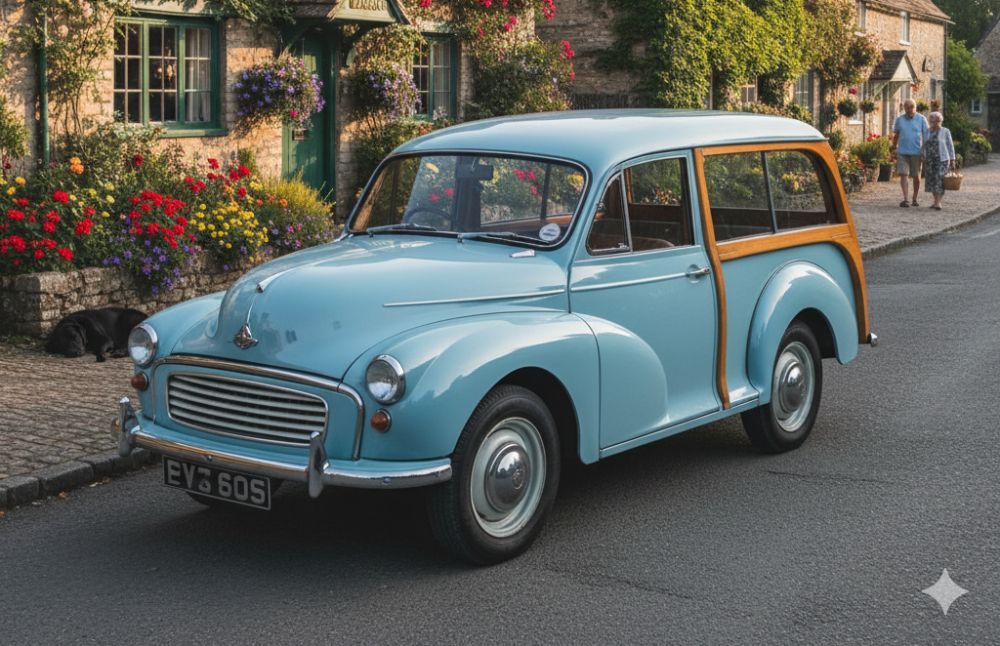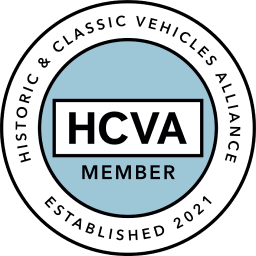Interchangeable Parts Guide: Finding Compatible Components for Classic British Cars

29 Oct 2025
When you're restoring a classic British motor, finding the right parts can feel like hunting for treasure. Original components have vanished, cost a fortune, or the modern replacements don't cut it. But here's the secret experienced restorers have known for decades: British manufacturers were brilliant at sharing parts across their model ranges.
During the post-war era, companies like BMC and British Leyland built entire vehicle families around the same core components. The same A-Series engine powered everything from the humble Morris Minor to the sporty MG Midget. Lucas electrical systems appeared across dozens of marques. This platform sharing means that when a specific part for your low-volume classic has dried up, there's often an identical component still in production for a higher-volume model.
Need more help with finding car parts that are not in production? Check out our guide on how to source discontinued car parts.
Quick Reference: Top 5 Money-Saving Interchangeable Parts
Before we get into the details, here are the most useful parts swaps for classic British car owners:
|
Component |
What Fits What |
Typical Saving |
|
Oil Filters |
A-Series engines → Modern spin-on filters (Mahle OC21, Mann W712) |
Save £10-15 per change |
|
Distributors |
Lucas 25D/45D cross-compatible: MGB, Triumph Spitfire, MG Midget, Morris Minor |
Electronic conversion saves £70-150 vs NOS units |
|
Clutch Kits |
6¼" BMC clutches fit Mini, Midget, Sprite, Minor, Herald, Spitfire Mk1 |
Save £50-80 vs vehicle-specific kits |
|
Universal Joints |
Source by dimension (SKF 1-0005/Spicer 5-4X) for TR6, Land Rover |
Save £30-55 vs branded classic parts |
|
Master Cylinders |
MGB GMC164 upgrades all pre-1977 single-circuit MGBs |
£115-136 for crucial safety upgrade |
Key Principle: Think industrial standard part numbers (SKF, Spicer, Timken, Lucas service numbers) rather than vehicle-specific catalogue numbers to unlock massive parts availability.
Start Your Search: Visit ifndautoparts.com and set up Match Me Alerts for any of these components. Our verified sellers specialise in cross-compatible parts and often have competitive pricing on these popular swaps.
VHI Status and Safety Upgrades
Before we get into specific swaps, here's something to clear up: will upgrading components affect your Vehicle of Historical Interest (VHI) status and MOT exemption?
Good news. DVLA and FBHVC guidance actively encourages safety improvements. Changes to axles and running gear that improve efficiency, safety, or environmental performance are fine. You can upgrade from drum to disc brakes or fit a dual-circuit master cylinder without losing your VHI status.
You must declare all significant modifications to your insurer, especially safety-critical components like brakes, steering, and suspension. Specialist classic car insurers understand these upgrades and typically offer agreed value policies that properly protect your investment.
Engine Upgrades That Actually Work
Spin-On Oil Filter Conversion (BMC A-Series)
If you're running an A-Series engine in your Mini, Midget, Sprite, or Morris Minor, you'll know the pain of those messy canister oil filters. The seals leak, quality cartridges are getting scarce, and the whole process is unnecessarily complicated.
The Solution: Fit a spin-on filter adaptor kit that converts your filter head to the standard 3/4-16 UNF thread. This lets you use widely available modern filters that are cleaner, cheaper, and easier to change.
What You Need:
- Adaptor plate kit (typically £35-£65) - search for "A-Series spin-on oil filter adaptor" on ifndautoparts
- Modern spin-on filters like Mahle OC21, Mann W712, or K&N SO-1003
- Replacement filters cost just £5.67-£9.57
Set up a Match Me Alert on ifndautoparts for A-Series oil filter conversion kits. You'll be notified when verified sellers list these adaptors, often at competitive prices from specialists who understand classic BMC applications.
Critical Check: Measure clearance in your engine bay before ordering. The spin-on canister is larger than the original cartridge, which can be tight in a Mini. Verify the adaptor matches the 3/4-16 UNF specification for your engine.
Lucas Distributor Family Interchangeability (25D/45D)
The Lucas 25D and 45D distributors powered nearly every classic British four-cylinder engine from the 1960s through the 1980s. When the mechanical advance wears out or points-based ignition becomes unreliable, you don't need to find the exact original unit.
The Solution: The core distributor housing design remained consistent across the entire 25D/45D family. You can cross-reference using the six-digit Lucas Service Number to find physically interchangeable units from different donor vehicles.
For example, Lucas Service Number 41593 (45DE4) was fitted to both the Triumph Spitfire 1500 and MG Midget 1500 from 1977-1980. These units are physically identical and fully interchangeable.
What You Need:
- Match the fixing method: Pre-1980 A-Series uses pinch clamp mounting; later A+ engines use two-bolt mounting (these are not interchangeable)
- Electronic ignition conversion kit (typically £45-£130)
- Verify your coil resistance matches the kit requirements (typically 1.5-3 ohms)
Pro Tip: Fitting an electronic ignition kit inside your original Lucas housing solves reliability issues and negates the internal differences between various mechanical units. This is often easier than sourcing a perfect mechanical replacement.
Search ifndautoparts for "Lucas 25D electronic ignition" or "Lucas 45D conversion kit" to find verified sellers offering quality electronic upgrades for your distributor.
Drivetrain Components
Engine components often get the most attention, but the drivetrain is where British manufacturers really excelled at standardisation. The same clutch assemblies, universal joints, and transmission components appeared across wildly different vehicles, from family saloons to sports cars. Great opportunities for cost-effective sourcing here.
Clutch Kit Interchangeability
The small BMC chassis family (Mini, Midget, Sprite, Morris Minor) used standardised clutch dimensions across multiple engine sizes. Loads of sourcing flexibility here.
The Key Specification: The 6¼-inch (159mm) clutch plate diameter was standard across BMC 803cc to 948cc engines and stayed consistent through various transmission types.
Compatible Applications:
- Morris Minor
- Austin A30/A40
- MG Midget Mk1-Mk3
- Austin-Healey Sprite
- Triumph Herald and Spitfire Mk1
- Even some Hillman and Sunbeam Imp models
What You Need: Modern three-piece diaphragm clutch kits from Borg & Beck (approximately £112-£144) are available from specialist suppliers. These provide better pedal feel and longer life than the original coil-spring pressure plates.
Critical Check: Verify spline count on your gearbox input shaft. Most A-Series applications use a 10-spline shaft, but some earlier units differ.
Check ifndautoparts for "6¼ inch BMC clutch kit" or set up a Match Me Alert for your specific model. Our verified sellers often stock these cross-compatible clutch kits at competitive prices.
Universal Joints: The Dimensional Approach
Once power leaves your gearbox, it travels through propshafts and half-shafts held together by universal joints. These wear items are often surprisingly expensive when sourced by vehicle-specific part numbers, but there's a smarter way.
Finding specific U-joints for Triumph TRs or early Land Rovers using original BL part numbers often leads to expensive dead ends. Better approach: source by dimension, not by vehicle application.
The Solution: U-joints are industrial products manufactured to global standards by companies like Spicer, SKF, and GMB. Many classic British models use U-joints that cross-reference to common industrial specifications.
What You Need to Measure:
- Outside Diameter (OD) of the bearing cup
- "Lock-Up" dimension (distance across yoke ears or snap rings)
- Retention style: Outside Snap Ring (OSR) or Inside Snap Ring (ISR)
Example Cross-Reference: Many Triumph TR6 and Land Rover applications use U-joints equivalent to Spicer 5-4X / SKF 1-0005 / Neapco 2805X.
Where to Source: Industrial bearing suppliers and SKF distributors offer these U-joints for £25-£45, significantly less than branded "classic car" parts.
Critical Warning: Mismatching the retention mechanism (OSR vs ISR) will either prevent installation or cause immediate driveline failure. Double-check this specification before ordering.
Safety-Critical Brake Upgrades
Now we move to the most important system on your classic: the brakes. This is about more than saving money. Many early British classics left the factory with braking systems that were adequate for 1960s traffic but feel terrifying on today's motorways.
MGB Dual-Circuit Master Cylinder
Early MGBs (pre-1977) used a single-circuit braking system. If any single line or component fails, you lose all braking. Terrifying prospect on modern roads. This upgrade is one of the most important safety modifications you can make.
The Solution: The factory dual-circuit master cylinder (GMC164) from 1977-onwards rubber-bumper MGBs provides two independent hydraulic circuits. If one circuit fails, you still have braking on at least one axle.
What You Need:
- GMC164 master cylinder (typically £115-£136 for quality remanufactured units)
- Potentially longer pushrod
- Additional brake line routing for the second circuit
- Possible union thread adapters
Critical Safety Check: The master cylinder bore size affects brake bias. If you're changing bore dimensions, you must verify the final hydraulic ratio maintains safe front-to-rear brake balance. Consider an adjustable bias valve and get a professional inspection before road testing.
This modification is explicitly endorsed under VHI rules as a safety improvement.
Search ifndautoparts for "MGB GMC164 master cylinder" or "MGB dual circuit brake upgrade" to find this critical safety component from verified sellers specialising in MGB parts.
Frequently Asked Questions About Interchangeable Parts
Will using interchangeable parts affect my classic car's value?
Period-correct upgrades and safety improvements generally maintain or increase value when properly documented. Collectors and enthusiasts understand that certain modifications like dual-circuit brakes or electronic ignition are sensible reliability and safety upgrades. Document what you've fitted and why, keep receipts, and make sure modifications are reversible where possible. Safety upgrades endorsed by organisations like the FBHVC actually protect value by keeping the car roadworthy and insurable.
Do I need to tell my insurance company about these swaps?
Yes, you must declare all significant modifications to your insurer, particularly safety-critical components like brakes, steering, suspension, and engine upgrades. Specialist classic car insurers understand that restoration often involves using interchangeable parts and safety improvements. They typically offer agreed value policies that properly protect your investment. Failing to declare modifications could invalidate your insurance, so always inform your insurer before making changes.
Where can I find reliable part compatibility information?
Best sources:
- Lucas service numbers for electrical components (six-digit codes that cross-reference across vehicles)
- Industrial part specifications from SKF, Spicer, Timken, and other bearing/component manufacturers
- Specialist suppliers' catalogues often show cross-compatibility information
- Marque-specific forums and clubs where experienced restorers share verified swaps
- Factory workshop manuals sometimes list alternative part numbers
- The ifndautoparts community where verified sellers and buyers share compatibility knowledge
For more information, see our detailed buyer's guide on sourcing classic car parts in the UK, including how to verify quality and find reputable suppliers.
How do I verify a part will fit before buying?
Always check these:
- Physical dimensions. Measure mounting points, bore sizes, thread pitches, and overall dimensions
- Fixing methods. Check bolt patterns, clamp types, and mounting hardware compatibility
- Specifications. Verify ratings like brake bore size, clutch diameter, bearing load capacities
- Thread standards. British cars use BSF, BSP, UNF, and UNC threads that are not always interchangeable
- Electrical compatibility. Check voltage, resistance, and connector types for electrical components
When in doubt, buy from suppliers with good return policies or ask specialists who know the specific application.
Will modifications affect my MOT exemption or VHI status?
Good news here. DVLA and FBHVC guidance actively encourages safety modifications. Changes to running gear that improve safety, efficiency, or environmental performance are fine. You can upgrade brakes, fit electronic ignition, or improve suspension and keep your VHI status. The exemption only gets lost if you make substantial changes to the chassis, body, suspension type (like beam axle to independent), or engine type (swapping a four-cylinder for a V8, for example).
Are reproduction parts as good as original components?
This varies by component and supplier. Some reproduction parts (brake components, suspension bushes, electrical items especially) can be worse than originals. Always buy from reputable UK suppliers who document their sourcing and quality control. For safety-critical items, inspect for proper heat treatment, correct materials, and accurate dimensions. Sometimes a modern industrial equivalent like SKF bearings or Spicer U-joints actually beats the original part because manufacturing standards have improved.
Can I mix and match parts from different model years?
Sometimes yes, sometimes no. British manufacturers often changed specifications mid-production run. Examples:
- A-Series engines switched from pinch-bolt to two-bolt distributor mounting in 1980
- MGB changed from single to dual-circuit brakes in 1977
- Many models got different clutch specifications as engine outputs changed
Always verify the specific year and specification of both your vehicle and the donor vehicle. Part numbers and service bulletins tell you more than general model year information.
What tools do I need to measure parts for compatibility?
For most verification work, grab these:
- Digital callipers (0-150mm minimum) for precise measurements
- Thread pitch gauge to identify BSF, UNF, metric threads
- Feeler gauges for checking clearances
- Micrometer for very precise measurements (bearing bores, etc.)
- Tape measure for larger components and clearance checks
- Notebook to record all measurements and part numbers
Basic kit costs under £50 and will save you hundreds in wrong parts and return postage.
The Bottom Line
The platform sharing British manufacturers used created a legacy of parts interchangeability that keeps classics running today. When you're searching for parts, think beyond your specific model. That "unobtainable" component might be sitting on a shelf under a different part number for a more common vehicle.
Key principles for successful swaps:
- Measure everything twice. Dimensional compatibility matters more than brand badges
- Check industrial standards. SKF, Spicer, and Timken numbers open up global parts availability
- Document your sources. Keep records of what fits what for future reference
- Prioritise safety. Always declare modifications to your insurer and get professional verification on brake and steering changes
- Join the community. Other restorers' experiences are gold for verifying compatibility
At ifndautoparts, we understand these challenges because we live them. Our Match Me Alerts system helps connect you with those rare components. Our community of verified sellers includes specialists who understand cross-platform compatibility. If you're hunting for an original part or researching alternatives, our platform brings together the knowledge and parts that keep British classics running.
Set up Match Me Alerts on ifndautoparts.com for hard-to-find components, browse our verified sellers who specialise in BMC, Triumph, MG, and Land Rover parts, or join our community forums to share compatibility discoveries with fellow restorers.
Because every part has a story, and every classic deserves to stay on the road.
Need help sourcing compatible components for your classic British car? Visit ifndautoparts.com and set up Match Me Alerts for the parts you need. Join a community of enthusiasts who understand that keeping classics running means thinking creatively about parts sourcing.
29 Oct 2025
Tags

